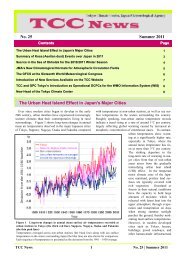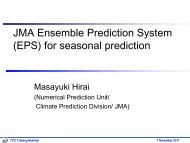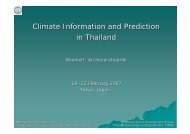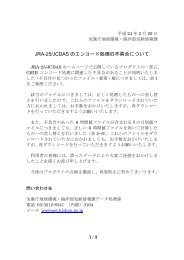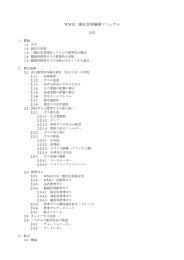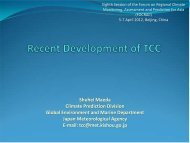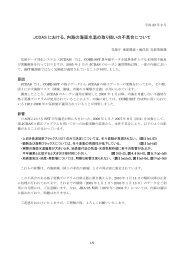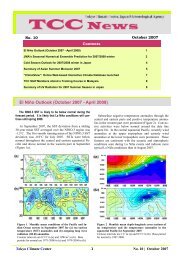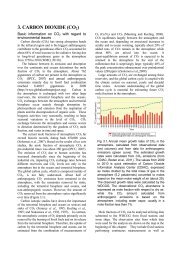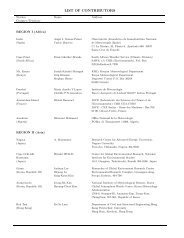TCC News No. 30
TCC News No. 30
TCC News No. 30
You also want an ePaper? Increase the reach of your titles
YUMPU automatically turns print PDFs into web optimized ePapers that Google loves.
(a) (b)<br />
Figure 3 Time-longitude cross sections of (a) SST and (b) ocean heat content (OHC) anomalies along the equator<br />
in the Indian and Pacific Ocean areas<br />
OHCs are defined here as vertical averaged temperatures in the top <strong>30</strong>0 m. The base period for the normal is 1981 – 2010.<br />
Western Pacific and Indian Ocean<br />
The area-averaged SST in the tropical western Pacific<br />
(NINO.WEST) region was below normal in<br />
September, and is likely to be near normal or below<br />
normal in the months ahead.<br />
The area-averaged SST in the tropical Indian<br />
Ocean (IOBW) region was near normal in September,<br />
and is likely to be near normal in the months ahead.<br />
(Ichiro Ishikawa, Climate Prediction Division)<br />
* The SST normals for the NINO.WEST region (Eq.<br />
– 15°N, 1<strong>30</strong>°E – 150°E) and the IOBW region (20°S<br />
– 20°N, 40°E – 100°E) are defined as linear extrapolations<br />
with respect to a sliding <strong>30</strong>-year period in<br />
order to remove the effects of long-term trends.<br />
According to JMA’s seasonal ensemble prediction<br />
system, convection is expected to be active over the<br />
tropical Indian Ocean and the central equatorial Pacific<br />
and inactive around the Maritime Continent and east of<br />
the Philippines. In association with active convection<br />
over the tropical Indian Ocean, the sub-tropical jet stream<br />
is expected to shift northward over the western part of<br />
the Eurasian Continent and air temperatures are expected<br />
to be above normal around South Asia. Conversely, negative<br />
anomalies of air temperature are expected over the<br />
mid-latitudes of the Eurasian Continent.<br />
Figure 4 Outlook of NINO.3 SST deviation produced by<br />
the El Niño prediction model<br />
This figure shows a time series of monthly NINO.3 SST deviations.<br />
The thick line with closed circles shows observed SST<br />
deviations, and the boxes show the values produced for the next<br />
six months by the El Niño prediction model. Each box denotes<br />
the range into which the SST deviation is expected to fall with a<br />
probability of 70%.<br />
JMA’s Seasonal Numerical Ensemble Prediction for Winter 2012/2013<br />
1. Introduction<br />
This article outlines JMA’s dynamical seasonal ensemble<br />
prediction for winter 2012/2013 (December 2012 –<br />
February 2013, referred to as DJF), which was used as a<br />
basis for the Agency’s operational cold-season outlook<br />
issued on 25 October, 2012. The outlook shown here is<br />
based on the seasonal ensemble prediction system of the<br />
Coupled atmosphere-ocean General Circulation Model<br />
(CGCM). See the column below for details of the system.<br />
Section 2 outlines global SST anomaly predictions, and<br />
Section 3 describes the circulation fields expected over<br />
the tropics and sub-tropics in association with these<br />
anomalies. Finally, the circulation fields predicted for the<br />
mid- and high latitudes of the <strong>No</strong>rthern Hemisphere are<br />
discussed in Section 4.<br />
<strong>TCC</strong> <strong>News</strong> 2 <strong>No</strong>. <strong>30</strong> | Autumn 2012



